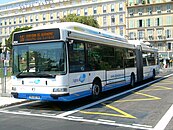Irisbus Agora
This article needs additional citations for verification. (February 2016) |
| Irisbus Agora | |
|---|---|
 Renault Agora Standard (S) in Reims in April 2011 | |
| Overview | |
| Manufacturer | Renault Irisbus |
| Body and chassis | |
| Doors | 1 door (United Kingdom and Australia) 1, 2, 3 or 4 doors (Europe) |
| Floor type | Low-floor |
| Powertrain | |
| Engine | Renault MIDR 062045 Iveco Cursor F2B |
| Capacity | 34 to 75 seated |
| Power output | 186 kW (249 hp) (Renault) 189 kW (253 hp)-213 kW (286 hp) (Iveco) |
| Transmission | Voith DIWA 3-speed automatic ZF Ecomat 4-speed automatic |
| Dimensions | |
| Length | 11,990 mm (472.0 in) (Agora S) |
| Width | 2,500 mm (98.4 in) |
| Height | 2,924 mm (115.1 in) |
| Curb weight | 11,380 kg (25,090 lb) |
| Chronology | |
| Predecessor | Renault R312 |
| Successor | Irisbus Citelis |
The Irisbus Agora (previously known as Renault Agora, Karosa City Bus or Ikarus Agora) was a low-floor bus designed and built by Renault from 1995 to 2002, date upon which it has been built by Irisbus, firstly a joint-venture with Fiat subsidiary Iveco from 1999, with Iveco engines. It has also been built by Czech-based Karosa under the Citybus name as a diesel-powered bus, and Skoda as a trolleybus in Eastern European markets as the Škoda 24Tr Irisbus and Škoda 25Tr Irisbus.
Range

The range consisted of:
- Standard 12-metre "S" version, available in one-, two- or three-door form
- Articulated 18-metre "L" version in three- or four-door form
- "Line" 12-metre version in one, two or three-door form (built from 1999). This version is distinct from the standard Agora by its engine layout, which is longitudinally-mounted (under the rear passenger seats) instead of being transverserly mounted in the Agora S and L. That gives the Line version a slightly greater seating capacity and a better fuel economy over the S version. This version was briefly sold in the United Kingdom, in right hand drive.
- Intercity version called "Moovy" (unveiled in 2003) which was based on the Agora Line.
Operators
Over 11,000 were built, mainly for European operators. Right hand drive countries for English and Australian bus operators have 1 door only.
Europe
The RATP Group was the largest purchaser with over 2,500. Standard Agora buses have been used by Athens bus operator OASA in two versions: diesel and CNG.
United Kingdom
In England, 23 were bodied by Optare, the majority for Norfolk County Council for its Norwich park and ride services.[1]
Australia
In Australia, a batch was ordered by King Brothers. Six Northcoast Bus & Coach bodied examples were delivered, however a larger order for Custom Coaches and Australian Bus Manufacturers bodied examples was reneged on and amongst the operators to purchase them were ACTION (20), Baxter's Bus Lines (5), Fearne's (5) and Thompsons Bus Service (5).[2]
Gallery
-
Compagnie des Transports Strasbourgeois Standard (S) Irisbus Agora in Strasbourg in March 2007
-
A Articulated (L) Irisbus Agora in Nice in July 2007
-
A Irisbus Agora Line in Lieusaint in January 2012
-
Empresa Municipal de Transportes de Madrid Renault Agora Line in Madrid in February 2007
-
Lignes d'Azur's Irisbus Agora S in April 2017
References
- ^ Optare - Agora Line Bus Lists on the Web
- ^ Kings for a day Sydney Morning Herald 10 May 2003
External links
 Media related to Renault Agora at Wikimedia Commons
Media related to Renault Agora at Wikimedia Commons Media related to Irisbus Agora at Wikimedia Commons
Media related to Irisbus Agora at Wikimedia Commons






